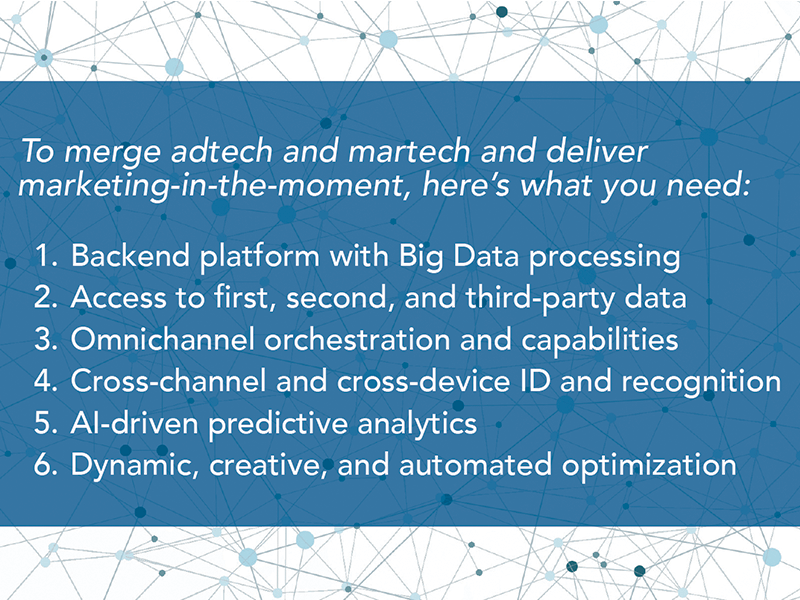Opinions expressed in this article are those of the sponsor. Search Engine Land neither confirms nor disputes any of the conclusions presented below.
Marketing in a distracted, digital world
In today’s world, digital media is so pervasive that it’s no longer considered unique; it’s a way of life. Virtually everyone has a smartphone, and most individuals and households have multiple smart devices, including tablets, phones and computers. This prevalence, coupled with the rise of Big Data, digital marketing tools and social media, has given […]

In today’s world, digital media is so pervasive that it’s no longer considered unique; it’s a way of life. Virtually everyone has a smartphone, and most individuals and households have multiple smart devices, including tablets, phones and computers. This prevalence, coupled with the rise of Big Data, digital marketing tools and social media, has given marketers the power to pinpoint specific audiences with advertising messages.
But while advertisers continue to pour money into digital media, consumers are so saturated that they’ve begun ignoring ads or actively avoiding them. The rise of ad fraud, where clicks are falsified to drive up cost per click (CPC) and bid rates, has resulted in billions of wasted advertising dollars, with real people only viewing about 40 percent of digital ads.1 To connect with consumers today, marketers need to re-think their strategy and focus on creating quality brand experiences, rather than on high-volume ad exposure. It’s time to take a second look at your approach and put people first.
Can we have your attention?
People today are more distracted than ever, with multiple screens and devices being used at all-time high rates, often at the same time. Have you ever searched something on your phone or tablet while also working on a laptop or watching TV? Then you know what marketers are up against. Our attention spans have plummeted as a result of digital overload — consumers now have an average attention span of just eight seconds.2 That means advertisers have a better chance of keeping a goldfish’s attention than the average person.
Streaming websites like Netflix gave rise to another key consumer trend: cord-cutting, which began with people canceling subscription cable and opting to stream TV shows ad-free instead. Cord-cutting has spread to other media, with more and more consumers choosing to tune out traditional advertising channels, including social media. Feeds have become so flooded with ads that people either ignore them or stop logging in completely. And on desktops and browsers, consumers are actively avoiding ads: an estimated 69.8 million Americans have installed ad-blocking software.3 When you add it all up, it makes breaking through the noise and being heard more than hard. It’s now close to impossible.
Rocky market, rising fraud
Advertising is still crucial to acquiring new customers, and new digital marketing tools have made it easier for advertisers to pinpoint and target specific audiences and segments. Digital spending continues to grow, but as buying becomes more and more automated, it becomes less and less efficient. Automation tools and programmatic buying opened up the market to ad fraud, with some estimating that click fraud now accounts for up to 50 percent of all ad traffic.4 According to Forrester, 60 percent of digital ads are never viewed by actual humans, which resulted in $7.4 billion wasted on badly placed ads in 2016 alone.1
Too many tools
While the buying journey — the clicks, views and touches between a person’s initial interest in a product and their actual purchase — is more complex than ever, consumers expect a unified, consistent experience wherever they are. Forrester reports that 62 percent of online adults in the US are now “always addressable,” meaning they shop using multiple devices from multiple locations.5 As they click, view and act across multiple screens, devices and channels, they expect to meet consistent messages. That’s why marketers need to take an omnichannel approach and deliver the same strong message to users across touches to tell their brand stories.
If you’re using multiple tools to manage multiple channels, you may in effect be competing with yourself for the same customers, which results in “cannibalized” budgets and wasted money. Getting it right with effective cross-channel marketing not only boosts digital media spend efficiency and ROI, it also increases acquisition rates and customer lifetime value. Brands that stand for something, rather than just selling something, boost loyalty and win buy-in from potential customers.
Understanding intent
The missing link for many marketers is understanding customer intent. While some segments, audiences and personas may fit the prospective buyer bill perfectly, targeting them at a time when they have no intention of buying is a waste of money. At the same time, tools that focus on demographic information alone can overlook consumers who don’t fit your profile but who are actually ready to buy.
Predictive analytics uses Big Data and machine learning to identify consumers with a high propensity to purchase, enabling marketers to target them at the right time and turn browsers into buyers. Artificial intelligence (AI) and machine learning can be used to analyze billions of clicks and differentiate between a browser and a buyer, even before the consumer makes their intentions known. AI-driven marketing tools can automate responses based on predicted intent, so if it looks like a consumer is likely to buy, marketers can present an offer or invite them to chat with a live agent trained to close the deal. If it looks like a shopper is going to abandon their cart, additional content or customized options can be delivered to prompt them to complete the purchase.
Personal is powerful
At the same time, AI-driven technologies can take traditional demographics to a whole new level, identifying highly specific individualized aesthetics based on billions of previous interactions. By tailoring colors, copy, images and other elements to give people creative they respond to, the brand experience becomes more meaningful and more effective.
According to McKinsey, personalization can reduce acquisition costs by as much as 50 percent, lift revenues by 5 to 15 percent and increase marketing spend efficiency by 10 to 30 percent.6 Which explains why Forrester found that personalization is a priority for 68 percent of firms, though 53 percent lack the technology to implement it effectively at scale.7 For marketers wanting to create one-to-one personalized ads and messages, it’s time to invest in smarter tools.
Quality over quantity
Gone are the days of assuming that more ads = more customers. So what’s the new paradigm for acquisition? Smart marketers are abandoning the sales funnel concept and instead focusing on individual customer journeys, which can be complex but are also often predictable. To guide customers down the path from casual interest to completing a purchase, marketers need to evolve from a channelcentric view to a journey-based approach that cuts across channels and focuses on creating quality experiences. This shift also allows marketers to minimize the impact of consumer saturation and ad fraud and build trust in their brand.
Marketing in the moment: Madtech
The way forward is all about marketing in the moment, based on individual intent. While a complex combination of factors drives a person’s behavior at any given moment, it’s possible to predict behavior by using the variables we can identify, including which device and site they’re on, time of day, local weather and recent purchases. With the right technology, marketers can anticipate consumer behavior based on the available data and past behavior and automate the best responses.
By combining traditional ad tech, which uses third-party data to enable audience segmentation at scale, and marketing automation, or martech, which focuses on rich profiling and one-to-one personalization, marketers can deliver dynamic brand experiences in the moment. Madtech offers a strategic way to cut through the noise, overcome consumer saturation and make meaningful connections that will help you both acquire new customers and retarget existing customers.
In a world where digital is so ubiquitous that it’s become a way of life, consumers are so saturated with digital ads that they often ignore or actively avoid them. With mobile device use at an all-time high and consumer attention spans at an all-time low, marketers need to shift their focus in order to break through the digital noise and be heard. Volume of ad exposure can no longer guarantee acquisition of new customers or increased conversion rates.
Instead, it’s time to focus on quality. The rise of AI and new marketing tools offers smart marketers a new approach: Combine an omnichannel platform with dynamic personalization at scale, and predictive analytics to understand consumer intent in the moment. Delivering the right message, to the right person, at the right time will enable marketers to create quality brand experiences, increase customer lifetime value, and acquire new customers more efficiently. Putting people first is the way of the future.
To learn more about how consumers digital behavior has shifted and how to transform your digital marketing strategy, check out our recent white paper, “The CMO’s Guide to Digital Transformation.”
1 Forrester Research, “The End of Advertising As We Know It,” May 2017.
2 Microsoft 2015: Attention spans: Consumer Insights, Microsoft Canada
3 eMarketer, September 13, 2016: “Tired of Being ‘Bombarded,’ US Internet Users Turn to Ad Blockers.”
4 Ronan Shields, ExchangeWire, April 14, 2014: “Click Fraud And How To Detect It.”
5 Susan Bidel and Richard Joyce, Forrester Research, November 10, 2015: “The Forrester Wave™: Data Management Platforms, Q4 2015.”
6 Brian Gregg, Hussein Kalaoui, Joel Maynes, and Gustavo Schuler, McKinsey & Company, November 2016: “Marketing’s Holy Grail: Digital personalization at scale.”
7 Maria Page, SmarterHQ Blog, December 22, 2106: “4 Priorities for Retail Marketers in 2017.”
Related stories
New on Search Engine Land


![Sponsored Content: [24]7.ai](/images/authors/SponsoredContent24-7-lg.jpg)